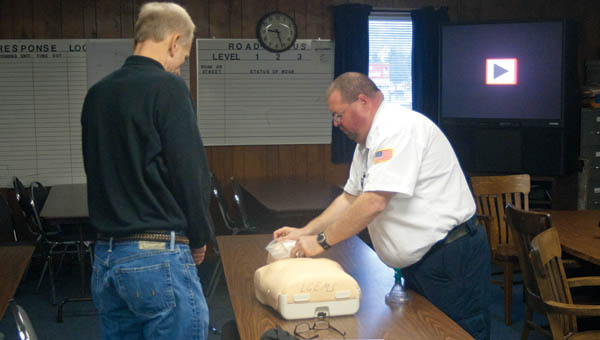Stayin’ Alive
Published 9:15 am Thursday, October 31, 2013

Ironton City Solicitor Bob Anderson, left, looks on as Lawrence County Emergency Medical Services Training Coordinator Steven Harrison, right, places a face barrier over a dummy as part of a Heartsaver CPR training class.
Courthouse employees get CPR training
When the Bee-Gees song “Stayin’ Alive” topped the charts in 1977, there is no way the Gibb brothers could have known their song would be used to keep people doing just that.
The conventional method of administering cardiopulmonary resuscitation (CPR) is to count 100 chest compressions per minute, or to the beat of the aforementioned song, until paramedics arrive.
Lawrence County Emergency Medical Service Training Coordinator Steven Harrison conducted a two-day CPR class at the EMA building in Ironton this week that allowed people to earn their adult, child and infant CPR cards.
“Several of the students took the class several years ago, so this served as an update for those whose cards have expired,” Harrison said. “For those taking the class the first time, it provides direction for responding to cardiac emergencies and familiarity with the automatic external defibrillator in the courthouse.”
The automatic external defibrillator (AED) is a portable machine that measures a person’s heart rhythm and determines if CPR needs to be administered.
“It’s very easy to use and walks you through every step,” Harrison said. “If a person can count to three, they can use an AED.”
Most buildings in which many people congregate has an AED. After applying sensor pads to the victim and reading his or her heart rate, the AED uses voice prompts and advises whether to shock the person. A shock is administered by pressing a button and the AED uses another voice prompt to signal when to begin administering CPR.
“AEDs are designed to work even if the person has the most minimal understanding of the machine,” Harrison said. “The buttons and colors are all specific to their function.”
Five different topics were taught in the class, which were basic chest compressions, giving breaths mouth-to-mouth, giving breaths using a mask, AED training and choking.
“If an infection or injury prevents a person from administering breaths,” Harrison said, “hands-only CPR is the best option.”
There are many basic rules that are vital to administering CPR, Harrison said, and remembering those simple rules is beneficial.
“For chest compressions, push down at least two inches at the 100 compressions per minute rate,” he said. “You should give the person 30 chest compressions and two breaths five times, which takes about two minutes.”
Ironton City Solicitor Bob Anderson was in the class Wednesday morning and said he received CPR training 30 years ago, but things have changed since the early 1980s.
“I’ve never had to administer CPR to anyone and I hope I never have to,” Anderson said. “The procedures and technology have changed significantly over the years.”
The class is taught using guidelines set forth by the American Heart Association and is taught concurrently with a training DVD. The DVD has drumbeats that aid in the pace of chest compressions and simulated breaths for mouth-to-mouth training.
Harrison spoke about the real-life scenario of breaking a person’s ribs during CPR, which is a common occurrence.
“It’s just going to happen,” he said. “There was a lady from Proctorville who I administered CPR to and she lived. When she got better she came to see me. She had a card signed by her family and kept thanking me over and over. I apologized for breaking a couple of her ribs and she told me she’d take being a little sore and alive over the alternative any day.”





